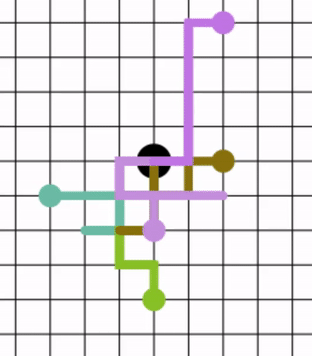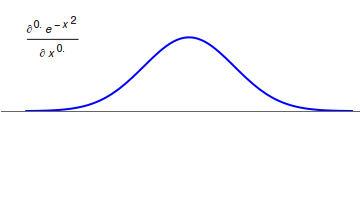|
Continuous-time Random Walk
In mathematics, a continuous-time random walk (CTRW) is a generalization of a random walk where the wandering particle waits for a random time between jumps. It is a stochastic jump process with arbitrary distributions of jump lengths and waiting times. More generally it can be seen to be a special case of a Markov renewal process. Motivation CTRW was introduced by Montroll and Weiss as a generalization of physical diffusion processes to effectively describe anomalous diffusion, i.e., the super- and sub-diffusive cases. An equivalent formulation of the CTRW is given by generalized master equations. A connection between CTRWs and diffusion equations with fractional time derivatives has been established. Similarly, time-space fractional diffusion equations can be considered as CTRWs with continuously distributed jumps or continuum approximations of CTRWs on lattices. Formulation A simple formulation of a CTRW is to consider the stochastic process X(t) defined by : X(t) = ... [...More Info...] [...Related Items...] OR: [Wikipedia] [Google] [Baidu] |
Random Walk
In mathematics, a random walk, sometimes known as a drunkard's walk, is a stochastic process that describes a path that consists of a succession of random steps on some Space (mathematics), mathematical space. An elementary example of a random walk is the random walk on the integer number line \mathbb Z which starts at 0, and at each step moves +1 or −1 with equal probability. Other examples include the path traced by a molecule as it travels in a liquid or a gas (see Brownian motion), the search path of a foraging animal, or the price of a fluctuating random walk hypothesis, stock and the financial status of a gambler. Random walks have applications to engineering and many scientific fields including ecology, psychology, computer science, physics, chemistry, biology, economics, and sociology. The term ''random walk'' was first introduced by Karl Pearson in 1905. Realizations of random walks can be obtained by Monte Carlo Simulation, Monte Carlo simulation. Lattice random ... [...More Info...] [...Related Items...] OR: [Wikipedia] [Google] [Baidu] |
Stochastic
Stochastic (; ) is the property of being well-described by a random probability distribution. ''Stochasticity'' and ''randomness'' are technically distinct concepts: the former refers to a modeling approach, while the latter describes phenomena; in everyday conversation, however, these terms are often used interchangeably. In probability theory, the formal concept of a '' stochastic process'' is also referred to as a ''random process''. Stochasticity is used in many different fields, including image processing, signal processing, computer science, information theory, telecommunications, chemistry, ecology, neuroscience, physics, and cryptography. It is also used in finance (e.g., stochastic oscillator), due to seemingly random changes in the different markets within the financial sector and in medicine, linguistics, music, media, colour theory, botany, manufacturing and geomorphology. Etymology The word ''stochastic'' in English was originally used as an adjective with the ... [...More Info...] [...Related Items...] OR: [Wikipedia] [Google] [Baidu] |
Jump Process
A jump process is a type of stochastic process that has discrete movements, called jumps, with random arrival times, rather than continuous movement, typically modelled as a simple or compound Poisson process. In finance, various stochastic models are used to model the price movements of financial instruments; for example the Black–Scholes model for pricing options assumes that the underlying instrument follows a traditional diffusion process, with continuous, random movements at all scales, no matter how small. John Carrington Cox and Stephen Ross proposed that prices actually follow a 'jump process'. Robert C. Merton extended this approach to a hybrid model known as jump diffusion Jump diffusion is a stochastic process that involves jump process, jumps and diffusion process, diffusion. It has important applications in magnetic reconnection, coronal mass ejections, condensed matter physics, and pattern theory and computationa ..., which states that the prices have large ... [...More Info...] [...Related Items...] OR: [Wikipedia] [Google] [Baidu] |
Markov Renewal Process
Markov ( Bulgarian, ), Markova, and Markoff are common surnames used in Russia and Bulgaria. Notable people with the name include: Academics * Ivana Markova (1938–2024), Czechoslovak-British emeritus professor of psychology at the University of Stirling *John Markoff (sociologist) (born 1942), American professor of sociology and history at the University of Pittsburgh * Konstantin Markov (1905–1980), Soviet geomorphologist and quaternary geologist Mathematics, science, and technology * Alexander V. Markov (born 1965), Russian biologist *Andrey Markov (1856–1922), Russian mathematician * Andrey Markov Jr. (1903–1979), Russian mathematician and son of Andrey Markov * Elena Vladimirovna Markova (1923–2023), Soviet and Russian cyberneticist, Doctor of Technical Sciences, gulag convict and memoirist. * John Markoff (born 1949), American journalist of computer industry and technology *Moisey Markov (1908–1994), Russian physicist * Vladimir Andreevich Markov (1871–1897), Russ ... [...More Info...] [...Related Items...] OR: [Wikipedia] [Google] [Baidu] |
Elliott Waters Montroll
Elliott Waters Montroll (May 4, 1916, in Pittsburgh, Pennsylvania – December 3, 1983, in Chevy Chase, Maryland) was an American scientist and mathematician. Education Elliott Montroll was born on May 4, 1916, in Pittsburgh, Pennsylvania, and received his elementary and high school education at the Dormont Public Schools. In 1933 he entered the University of Pittsburgh and in 1937 he received a BS degree in chemistry. From 1937 until 1939 he was a graduate assistant in the Mathematics Department of the University of Pittsburgh, and during the first semester of the school year 1939–1940 he carried out research in the Chemistry Department of Columbia University. He was awarded a Ph.D. in mathematics at the University of Pittsburgh in 1939, with a thesis ''Some Notes and Applications of the Characteristic Value Theory of Integral Equations'' in which he applied integral equations to the study of imperfect gases. A paper published jointly with Joseph E. Mayer in 1941 Statistica ... [...More Info...] [...Related Items...] OR: [Wikipedia] [Google] [Baidu] |
George Herbert Weiss
George H. Weiss (February 19, 1930 – February 14, 2017) was an American applied mathematician and physicist at the National Institutes of Health, known for his work on random walks. He did his undergraduate studies at the City College of New York and Columbia University, graduating in 1951, and earned a Ph.D. from the University of Maryland in 1958. Awards In 1967, Weiss and Marvin Zelen shared the Washington Academy of Sciences award for their contributions in Mathematics. Established in 1939, this award recognizes noteworthy accomplishments by young scientists (40 years of age and under). In May 2010, the NIH held a symposium entitled "Random Walks in Biology and Beyond", in honor of Weiss's 80th birthday and recent retirement. In July 2010, at the Mexican Meeting on Mathematical and Experimental Physics, Weiss was awarded the Leopoldo García-Colín-Scherer Medal. This medal has been established in 2001 and awarded every three years to recognize outstanding internationa ... [...More Info...] [...Related Items...] OR: [Wikipedia] [Google] [Baidu] |
Anomalous Diffusion
Anomalous diffusion is a diffusion process with a non-linear relationship between the mean squared displacement (MSD), \langle r^(\tau )\rangle , and time. This behavior is in stark contrast to Brownian motion, the typical diffusion process described by Albert Einstein and Marian Smoluchowski, where the MSD is linear in time (namely, \langle r^(\tau )\rangle =2dD\tau with ''d'' being the number of dimensions and ''D'' the diffusion coefficient). It has been found that equations describing normal diffusion are not capable of characterizing some complex diffusion processes, for instance, diffusion process in inhomogeneous or heterogeneous medium, e.g. porous media. Fractional diffusion equations were introduced in order to characterize anomalous diffusion phenomena. Examples of anomalous diffusion in nature have been observed in ultra-cold atoms, harmonic spring-mass systems, scalar mixing in the interstellar medium, telomeres in the nucleus of cells, ion channels in the plasm ... [...More Info...] [...Related Items...] OR: [Wikipedia] [Google] [Baidu] |
Master Equation
In physics, chemistry, and related fields, master equations are used to describe the time evolution of a system that can be modeled as being in a probabilistic combination of states at any given time, and the switching between states is determined by a transition rate matrix. The equations are a set of differential equations – over time – of the probabilities that the system occupies each of the different states. The name was proposed in 1940: Introduction A master equation is a phenomenological set of first-order differential equations describing the time evolution of (usually) the probability of a system to occupy each one of a discrete set of states with regard to a continuous time variable ''t''. The most familiar form of a master equation is a matrix form: \frac = \mathbf\vec, where \vec is a column vector, and \mathbf is the matrix of connections. The way connections among states are made determines the dimension of the problem; it is either *a d-dimension ... [...More Info...] [...Related Items...] OR: [Wikipedia] [Google] [Baidu] |
Fractional Derivative
Fractional calculus is a branch of mathematical analysis that studies the several different possibilities of defining real number powers or complex number powers of the differentiation operator D D f(x) = \frac f(x)\,, and of the integration operator J The symbol J is commonly used instead of the intuitive I in order to avoid confusion with other concepts identified by similar glyphs, such as identities. J f(x) = \int_0^x f(s) \,ds\,, and developing a calculus for such operators generalizing the classical one. In this context, the term ''powers'' refers to iterative application of a linear operator D to a function that is, repeatedly composing D with itself, as in \begin D^n(f) &= (\underbrace_n)(f) \\ &= \underbrace_n (f)\cdots))). \end For example, one may ask for a meaningful interpretation of \sqrt = D^ as an analogue of the functional square root for the differentiation operator, that is, an expression for some linear operator that, when applied to any f ... [...More Info...] [...Related Items...] OR: [Wikipedia] [Google] [Baidu] |
Laplace Transform
In mathematics, the Laplace transform, named after Pierre-Simon Laplace (), is an integral transform that converts a Function (mathematics), function of a Real number, real Variable (mathematics), variable (usually t, in the ''time domain'') to a function of a Complex number, complex variable s (in the complex-valued frequency domain, also known as ''s''-domain, or ''s''-plane). The transform is useful for converting derivative, differentiation and integral, integration in the time domain into much easier multiplication and Division (mathematics), division in the Laplace domain (analogous to how logarithms are useful for simplifying multiplication and division into addition and subtraction). This gives the transform many applications in science and engineering, mostly as a tool for solving linear differential equations and dynamical systems by simplifying ordinary differential equations and integral equations into algebraic equation, algebraic polynomial equations, and by simplifyin ... [...More Info...] [...Related Items...] OR: [Wikipedia] [Google] [Baidu] |
Characteristic Function (probability Theory)
In probability theory and statistics, the characteristic function of any real-valued random variable completely defines its probability distribution. If a random variable admits a probability density function, then the characteristic function is the Fourier transform (with sign reversal) of the probability density function. Thus it provides an alternative route to analytical results compared with working directly with probability density functions or cumulative distribution functions. There are particularly simple results for the characteristic functions of distributions defined by the weighted sums of random variables. In addition to univariate distributions, characteristic functions can be defined for vector- or matrix-valued random variables, and can also be extended to more generic cases. The characteristic function always exists when treated as a function of a real-valued argument, unlike the moment-generating function. There are relations between the behavior of the charact ... [...More Info...] [...Related Items...] OR: [Wikipedia] [Google] [Baidu] |


